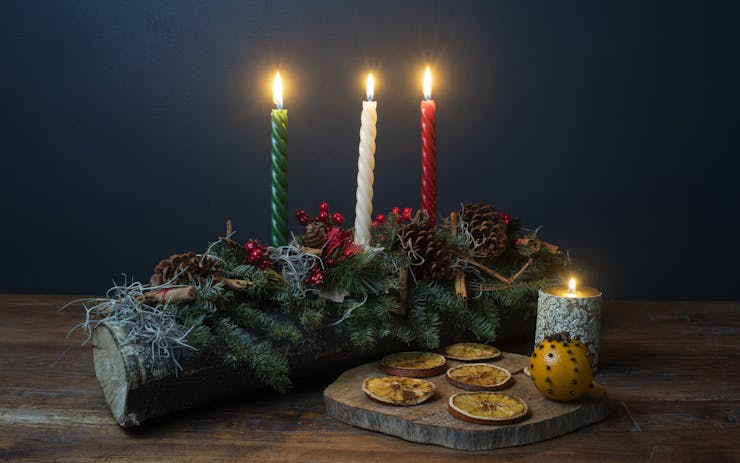Long before Christmas was all about the birth of Jesus Christ it was a celebration of the winter solstice, the longest night of the year, which falls between December 21 and 22. Pre-Christian people of Europe, often referred to as pagans, were intimately connected with the seasons and depended on the return of the sun—and plants—for survival. Though harsh winter months lay ahead, ancient Europeans turned the long, dark nights of late December into a party, known as Yule.
“Yule is the Germanic term for winter solstice,” explained Dr. Chris Klassen, religion and culture professor at Wilfrid Laurier University in Waterloo, Ontario. (“Germanic” being a loose term that includes most people of Europe in the past).
Because the days grow steadily longer after the winter solstice, ancient Yule celebrations were all about the returning sun. “Evergreen trees and boughs and wreathes were about bringing green—a symbol of spring and summer—into the home to remember life is being reborn,” said Klassen. “And of course Yule logs, which for ancient pagans were actual logs burning in the fireplace through the longest night, rather than cake.”
While belief systems have changed over the centuries, plants continue to play a central role at Christmastime: evergreens, holly, mistletoe, cinnamon, cloves, oranges, nuts, gingerbreads, potpourri—and even cannabis—are all carryovers from old traditions. Here are some of the historic ways cannabis brought symbolic green, good vibes, and festive merriment to the darkest days of the year.
Magic incense

Before they were the 12 Days of Christmas—Dec. 25 to Jan. 6—they were twelve “raw nights” when the pre-Christian god Wotan (Odin or Wodan) and his wild army galloped across the sky fighting a battle between light and darkness, also known as the Wild Hunt.
Not only did Wotan and his legion pluck unsuspecting people off the ground, but other lurking demons could surface on these long winter nights, too. To calm the gods and ward away evil before bedtime, pagans and early Christians smudged their homes and stables with an auspicious number of nine herbs, such as juniper, evergreen resins, milk thistle, mugwort, and likely cannabis, wrote Christian Rästch in Pagan Christmas.
Today, Catholic masses continue to burn terpene-rich frankincense on Christmas Eve, and some speculate the Wild Hunt is a foundational story of Santa and his reindeer flying through the sky.
Pipe dreams

“The stump of a pipe he held tight in his teeth / And the smoke, it encircled his head like a wreath,” wrote Clement Clarke Moore in his 1823 poem, A Visit from St. Nicholas (aka ‘Twas the Night Before Christmas).
Shop highly rated dispensaries near you
Showing you dispensaries nearThe jolly, pipe-smoking Santa icon harkens back to an bygone era of smoking of not just tobacco, but baccy: a pungent mixture of forest and meadow herbs smoked at Christmastime that often contained cannabis, according to Rästch. In Pagan Christmas, he wrote that Germans had a special word for the pop of cannabis seeds in their Christmas baccy, which they called knastert.
Rästch speculates the pipe-smoking, pagan mountain spirit Rübezahl was a precursor to the benevolent St. Nicholas, who later gave rise to the punishing Ru-klaus (“Rough Nicholas”) and the terrifying Krampus. Thanks to the creative work of 19th-century American poets like Moore, children today look forward to visits from a very merry Santa Claus, possibly kept in good humor by the contents of his pipe.
Beer fest
Many craft brewers today brew a limited-run Christmas ale or winter beer loaded up with herbs and spices, a centuries-old tradition tied to Yule. Northern Germanic cultures were especially fond of Julbeers—Norway even imposed a law in the 10th century stipulating every household brew their own beer for Yule or face heavy fines.
According to Rästch, Julbeers and Wodelbeers (Wodel = Wotan) could ignore strict brewing pureness laws

and toss in extra intoxicants at Yuletide for the warm fuzzies: cannabis, wormwood, and black henbane, along with fir greens and wild rosemary for flavor.
Hemp seed soup

In The Great Book of Hemp, Rowan Robinson writes of an old Christmas Eve tradition still seen in Poland and Lithuania today: semieniatka, or hemp seed soup, is offered to deceased family members who come back to visit their families over the holidays.
Robinson speculates the custom stretches back to ancient Scythian culture where cannabis was inextricably linked to rituals surrounding death and funerals.
Note: Scythians can also be grouped as pagans, which Klassen says means “people of the countryside,” used by Roman Christians to describe anyone who hadn’t converted.
Special mention: Fly agaric mushroom

Ever notice red and white mushrooms on old-timey Christmas illustrations? This is the fly agaric mushroom, or Amanita muscaria, a psychedelic fungus with ancient associations with the winter solstice. Many iterations of the Wild Hunt describe fly agaric mushrooms growing wherever Wotan rode through the clouds, which magically sprout nine months later, from the autumn equinox (September 21) to the end of December.
In the northernmost regions of Europe and Siberia, shamans are said to have eaten fly agaric mushrooms at the winter solstice. Until recently, scholars say indigenous Sami people of Lapland waited in their tents on the longest night for a shaman to arrive on a reindeer-drawn sled. Inside, he would consume fly agaric mushrooms
and bestow “gifts” of healing and advice from another realm onto the family, who would then feed the holy man for his service. These well-fed shamans dressed in red and white to honor the power and magic of these mushrooms, which allegedly gave people the sensation of flying through the sky.





